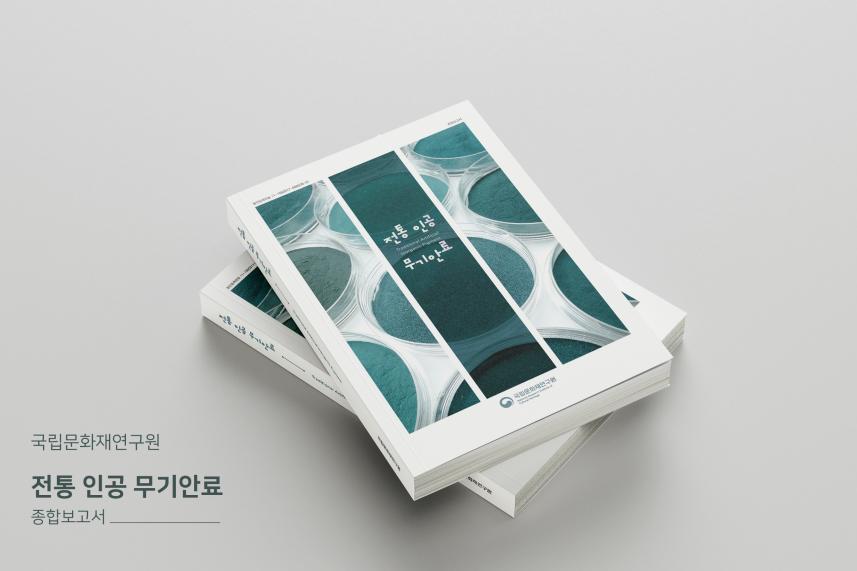단절된 전통 인공 무기안료 복원 성과 및 품질기준 수록
문화재청 국립문화재연구원(원장 김연수)은 사라진 전통 인공 무기안료를 복원하고 품질기준 연구 성과를 담은 보고서 「전통 인공 무기안료」를 발간했다.
* 무기안료(無機顔料): 화학적으로 무기질인 안료로, 천연광물 그대로 또는 천연광물을 가공‧분쇄하여 만든 것과 금속화합물을 원료로 하여 만드는 것이 있음
우리나라는 예부터 사찰, 궁궐 등 주요 목조건축물의 목부재를 보호하고 건축물의 격에 맞는 장식을 위해 천연 및 인공 안료로 단청을 칠하였다. 그러나 19세기 말부터 가격이 저렴하고 수급이 용이한 화학안료가 유입되면서 전통안료의 수요가 줄어들었고, 이에 따라 자연히 전통안료의 제조기술과 시공기술이 단절되어 문화재 수리 현장에 적용하기 어려워졌다.
이에 국립문화재연구원에서는 단청용 전통안료를 복원하고 문화재 수리 현장에 안정적으로 적용하기 위해 ‘전통 단청안료 제조기술 및 품질기준 연구’를 진행해왔다. 먼저, 2014년부터 2018년까지 천연 무기안료에 대한 연구를 진행하였으며, 그 일환으로 2020년에는 연구 성과를 담은 보고서 「천연 무기안료」를 발간한 바 있다.
이번에 발간한 「전통 인공 무기안료」 보고서는 2019년부터 2022년까지 4년간 전통 인공 무기안료를 대상으로 진행한 연구 성과를 담은 것으로 ▲ 단청용 전통 인공 무기안료의 특성 규명, ▲ 전통 제조법에 대한 원천기술 확보 및 품질기준 마련, ▲ 연구과정에서 획득한 재현안료, 시판안료에 대한 과학적 분석 정보 등 주요 핵심결과를 수록하였다.
특히 녹색안료 ‘동록(銅綠)’의 전통 제조법 복원 성과와 동록(銅綠), 회청(回靑), 연단(鉛丹), 밀타승(密陀僧), 연백(鉛白) 등 전통 인공 무기안료 5종에 대한 정의와 성분 기준 및 성능 기준, 시험 방법을 담은 ‘전통 인공 무기안료 품질기준’ 등 이번 연구의 주요 성과들도 보고서를 통해 확인할 수 있다.
* 동록(銅綠): 구리 혹은 구리합금을 염(salt) 부식시켜 인공적으로 제조한 녹색 안료
* 회청(回靑): 코발트를 석영 등의 무기물질과 함께 유리질화하여 인공적으로 제조한 청색 안료
* 연단(鉛丹): 납 또는 산화납을 가열하여 인공적으로 제조한 적색 안료
* 밀타승(密陀僧): 납 또는 산화납을 가열하여 인공적으로 제조한 황색 안료
* 연백(鉛白): 납을 부식시켜 인공적으로 제조한 백색 안료
보고서는 모든 국민이 열람할 수 있도록 문화재청 누리집(www.cha.go.kr)과 국립문화재연구원 문화유산연구지식포털(https://portal.nrich.go.kr)에 공개한다.
문화재청 국립문화재연구원은 이번 보고서가 전통 단청안료의 보존과 계승 발전에 중요한 자료로 활용되길 기대하며, 앞으로도 전통재료 복원 및 품질 연구를 꾸준히 추진해 문화재 수리·복원용 재료의 진정성과 수리 품질을 높이기 위해 노력할 것이다.
The National Research Institute of Cultural Heritage (NRICH, Director General Kim Yeonsoo) under the Cultural Heritage Administration (CHA) of Korea published a report, 『Traditional Artificial Inorganic Pigment』 including the restoration of disconnected traditional artificial inorganic pigments and research achievements of quality standards.
* Inorganic pigment: As a pigment made up of chemically inorganic materials, it is manufactured with the natural mineral itself or with processed and pulverized natural minerals, and with metallic compounds
In Korea, to protect and decorate major elements of wooden structures such as temples and palaces for maintaining their dignity, Dancheong has been painted with the natural and artificial pigments from the past. But since the end of the 19th century, cheaper and easily supplied chemical pigments have been brought into Korea and caused decrease in demand for those traditional pigments. Therefore, the manufacturing techniques and application methods about traditional pigments were naturally disconnected, which led to difficulties in application to repair for the cultural heritage on the site.
In this context, the NRICH carried out ‘Research on Manufacturing Techniques and Quality Standards of Traditional Pigments used for Dangcheong’ to restore Dancheong pigments and to prepare plans for applying them stably to the side of cultural heritage. The research targeted the natural inorganic pigments (2014-2018) and then the artificial inorganic pigments (2019-2022), and the report including research outcomes of the natural inorganic pigments was published in 2020.
The newly published report this time presents the research achievements of traditional artificial inorganic pigments for 4 years since 2019, including main research outcomes such as identifying characteristics on traditional artificial inorganic pigments, securing source technology of traditional manufacturing techniques, preparing quality standards as well as scientific analysis information on re-produced pigments obtained during the research and commercial pigments.
In particular, the notable accomplishment of this research is that the manufacturing technique of green pigment, ‘Dongrok’ referred to as the ‘Hayeop’ color was systematized and its material characteristics were scientifically investigated. Dongrok has been widely used for a variety of colored cultural heritage such as hanging Buddhist paintings and murals of temples as well as Dangcheong for a long time but its raw material was not clearly identified and manufacturing techniques were disconnected. However, this research secured the source technology for restoring Dongrok and provided significant academic materials for preparing the groundwork of production.
In addition, 『Quality Standards of Traditional Artificial Inorganic Pigments』 includes the standards of components, standards of performance and testing methodologies on the basis of definitions of five kinds of traditional artificial inorganic pigments such as Dongrok(copper green rust), Heocheong (smalt), Miltaseung (litharge), Yeondan (lead red) and Yeonbaek(lead white) through this research. The preparation for quality standards of natural inorganic pigments used for Dancheong was followed by the preparation for quality standards of traditional artificial inorganic pigments, which could be said that this research established the foundation for applying traditional pigments to the site stably and raised the completion level.
* Dongrok (銅綠, copper green rust): green pigment artificially made by corroding copper or copper alloy with salt
* Heocheong (回靑, smalt): blue pigment artificially made by vitrifying cobalt with inorganic materials such as quartz
* Yeondan (鉛丹, lead red): red pigment artificially made by heating lead or lead oxide
* Miltaseung (密陀僧, litharge): yellow pigment artificially made by heating lead or lead oxide
* Yeonbaek (鉛白, lead white): white pigment artificially made by corroding lead
This publication is open to the public and available to everyone through the homepage of CHA (www.cha.go.kr) and the homepage of NRICH research publications (http://portal.nrich.go.kr).
The National Research Institute of Cultural Heritage under the Cultural Heritage Administration of Korea expects this report to be utilized as significant materials for the development to preserve and inherit traditional pigments used for Dangcheong. Furthermore, it will make efforts to enhance authenticity of materials used for repair and restoration, and improve the quality of repair by steadily working on research of the restoration and quality of traditional materials.

< 「전통 인공 무기안료」 보고서 사진 >
 이 보도자료와 관련하여 더 자세한 내용 설명이나 취재를 원하시면 국립문화재연구원 복원문화재연구실
권혁남 연구관(☎042-860-9341), 이선명 연구사(☎042-860-9348)에게 연락해 주시기 바랍니다. |



